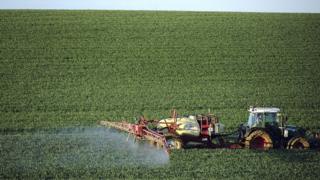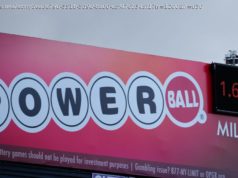 It has been called one of a biggest inventions of a 20th Century, and though it roughly half a world’s race would not be alive today.
It has been called one of a biggest inventions of a 20th Century, and though it roughly half a world’s race would not be alive today.
A hundred years ago dual German chemists, Fritz Haber and Carl Bosch, devised a approach to renovate nitrogen in a atmosphere into fertiliser, regulating what became famous as a Haber-Bosch process.
But Haber’s place in story is controversial.
He is also deliberate a “father of chemical warfare” for his years of work building and weaponising chlorine and other unwholesome gases during World War One.
Plants need nitrogen: it is one of their 5 simple requirements, along with potassium, phosphorus, H2O and sunlight.
In a healthy state, plants grow, they die, a nitrogen they enclose earnings to a soil, and new plants use it to grow.
Agriculture disrupts that cycle: we collect a plants, and eat them.
From a beginning days of agriculture, farmers detected several ways to forestall stand yields from disappearing over time: by restoring nitrogen to their fields.
Manure has nitrogen. So does compost.
The roots of legumes horde germ that feed nitrogen levels.
That is because it helps to embody peas or beans in stand rotation. Industrial process
But these techniques onslaught to entirely prove a plant’s ardour for nitrogen.
Add more, and a plant grows better.
That is accurately what Fritz Haber worked out how to do, driven in partial by a guarantee of a remunerative agreement from a chemical association BASF.
That company’s engineer, Carl Bosch, afterwards managed to replicate Haber’s routine on an industrial scale.
Both group after won Nobel Prizes – controversially, in Haber’s case, as many by afterwards deliberate him a fight criminal. Find out more
50 Things That Made a Modern Economy highlights a inventions, ideas and innovations that have helped emanate a mercantile universe we live in.
It is foster on a BBC World Service.
You can listen online or subscribe to a programme podcast .
The Haber-Bosch routine is maybe a many poignant instance of what economists call “technological substitution”, where we seem to have reached some simple earthy limit, afterwards find a workaround.
For many of tellurian history, if we wanted some-more food to support some-more people, afterwards we indispensable some-more land.
But a thing about land, as Mark Twain once joked, is that they are not creation it any more.
Haber and Bosch supposing a substitute: instead of some-more land, make nitrogen fertiliser.
It was like alchemy.
“Brot aus Luft”, as Germans put it, or “Bread from air”.
From atmosphere and utterly a lot of hoary fuels. How it is done
First of all, we need healthy gas as a source of hydrogen, a component to that nitrogen binds to form ammonia.
Then we need appetite to beget impassioned feverishness and pressure.
Haber detected that was required as a matter to mangle a holds between air’s nitrogen atoms and convince them to bond with hydrogen instead.
Imagine a feverishness of a wood-fired pizza oven, with a vigour we would knowledge 2km underneath a sea.
To emanate those conditions on a scale sufficient to furnish 160 million tonnes of ammonia a year – a infancy of that is used for fertilizer – a Haber-Bosch routine currently consumes some-more than 1% of all a world’s energy.
That is a lot of CO emissions. Environmental damage
And there is another really critical ecological concern.
Only some of a nitrogen in fertilizer creates a approach around crops into tellurian stomachs, maybe as small as 15%.
Most of it ends adult in a atmosphere or water.
This is a problem for several reasons.
Compounds like nitrous oxide are absolute hothouse gases.
They infect celebration water.
They also emanate poison rain, that creates soils some-more acidic, disrupting ecosystems, and melancholy biodiversity.
When nitrogen compounds run off into rivers, they further foster a expansion of some organisms some-more than others.
The formula embody sea “dead zones”, where blooms of algae nearby a aspect retard out object and kill a fish below.
The Haber-Bosch routine is not a usually means of these problems, though it is a vital one, and it is not going away.
Demand for fertilizer is projected to double in a entrance century.
In truth, scientists still do not entirely know a long-term impact on a sourroundings of converting so most stable, dead nitrogen from a atmosphere into several other, rarely reactive chemical compounds. Population growth
We are in a center of a tellurian experiment.
One outcome is already clear: copiousness of food for lots some-more people.
If we demeanour during a graph of tellurian population, we will see it fire upwards usually as Haber-Bosch fertilisers start being widely applied.
Again, Haber-Bosch was not a usually reason for a spike in food yields.
New varieties of crops like wheat and rice also played their part.
Still, if we farmed with a best techniques accessible in Fritz Haber’s time, a earth would support about 4 billion people.
Our stream race is around 7 and a half billion, and growing.
Back in 1909, as Haber triumphantly demonstrated his ammonia process, he could frequency have illusory how transformative his work would be.
On one side of a ledger, food to feed billions some-more tellurian souls; on a other, a sustainability predicament that will need some-more talent to solve.
For Haber himself, a consequences of his work were not what he expected.
As a immature man, he converted from Judaism to Christianity, painful to be supposed as a German patriot.
Beyond his work on weaponising chlorine, a Haber-Bosch routine also helped Germany in World War One.
Ammonia can make explosives, as good as fertiliser.
Not usually bread from air, though bombs too.






